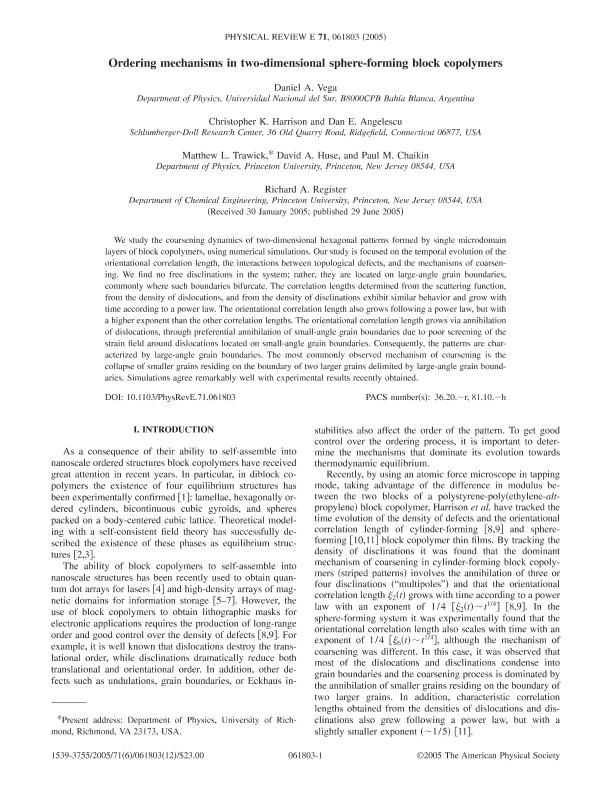Mostrar el registro sencillo del ítem
dc.contributor.author
Vega, Daniel Alberto

dc.contributor.author
Harrison, Christopher K.
dc.contributor.author
Angelescu, Dan E.
dc.contributor.author
Trawick, Matthew L.
dc.contributor.author
Huse, David A.
dc.contributor.author
Chaikin, Paul M.
dc.contributor.author
Register, Richard A.
dc.date.available
2019-04-03T17:49:23Z
dc.date.issued
2005-06-29
dc.identifier.citation
Vega, Daniel Alberto; Harrison, Christopher K.; Angelescu, Dan E.; Trawick, Matthew L.; Huse, David A.; et al.; Ordering mechanisms in two-dimensional sphere-forming block copolymers; American Physical Society; Physical Review E: Statistical, Nonlinear and Soft Matter Physics; 71; 6; 29-6-2005; 1-12
dc.identifier.issn
1539-3755
dc.identifier.uri
http://hdl.handle.net/11336/73071
dc.description.abstract
We study the coarsening dynamics of two-dimensional hexagonal patterns formed by single microdomain layers of block copolymers, using numerical simulations. Our study is focused on the temporal evolution of the orientational correlation length, the interactions between topological defects, and the mechanisms of coarsening. We find no free disclinations in the system; rather, they are located on large-angle grain boundaries, commonly where such boundaries bifurcate. The correlation lengths determined from the scattering function, from the density of dislocations, and from the density of disclinations exhibit similar behavior and grow with time according to a power law. The orientational correlation length also grows following a power law, but with a higher exponent than the other correlation lengths. The orientational correlation length grows via annihilation of dislocations, through preferential annihilation of small-angle grain boundaries due to poor screening of the strain field around dislocations located on small-angle grain boundaries. Consequently, the patterns are characterized by large-angle grain boundaries. The most commonly observed mechanism of coarsening is the collapse of smaller grains residing on the boundary of two larger grains delimited by large-angle grain boundaries. Simulations agree remarkably well with experimental results recently obtained.
dc.format
application/pdf
dc.language.iso
eng
dc.publisher
American Physical Society

dc.rights
info:eu-repo/semantics/openAccess
dc.rights.uri
https://creativecommons.org/licenses/by-nc-sa/2.5/ar/
dc.subject.classification
Biotecnología Industrial

dc.subject.classification
Biotecnología Industrial

dc.subject.classification
INGENIERÍAS Y TECNOLOGÍAS

dc.title
Ordering mechanisms in two-dimensional sphere-forming block copolymers
dc.type
info:eu-repo/semantics/article
dc.type
info:ar-repo/semantics/artículo
dc.type
info:eu-repo/semantics/publishedVersion
dc.date.updated
2019-03-15T19:22:13Z
dc.journal.volume
71
dc.journal.number
6
dc.journal.pagination
1-12
dc.journal.pais
Estados Unidos

dc.journal.ciudad
Maryland
dc.description.fil
Fil: Vega, Daniel Alberto. Consejo Nacional de Investigaciones Científicas y Técnicas. Centro Científico Tecnológico Conicet - Bahía Blanca; Argentina. Universidad Nacional del Sur. Departamento de Física; Argentina
dc.description.fil
Fil: Harrison, Christopher K.. Schlumberger-Doll Research Center; Estados Unidos
dc.description.fil
Fil: Angelescu, Dan E.. Schlumberger-Doll Research Center; Estados Unidos
dc.description.fil
Fil: Trawick, Matthew L.. University of Princeton; Estados Unidos
dc.description.fil
Fil: Huse, David A.. University of Princeton; Estados Unidos
dc.description.fil
Fil: Chaikin, Paul M.. University of Princeton; Estados Unidos
dc.description.fil
Fil: Register, Richard A.. University of Princeton; Estados Unidos
dc.journal.title
Physical Review E: Statistical, Nonlinear and Soft Matter Physics

dc.relation.alternativeid
info:eu-repo/semantics/altIdentifier/url/https://journals.aps.org/pre/abstract/10.1103/PhysRevE.71.061803
dc.relation.alternativeid
info:eu-repo/semantics/altIdentifier/doi/http://dx.doi.org/10.1103/PhysRevE.71.061803
Archivos asociados
